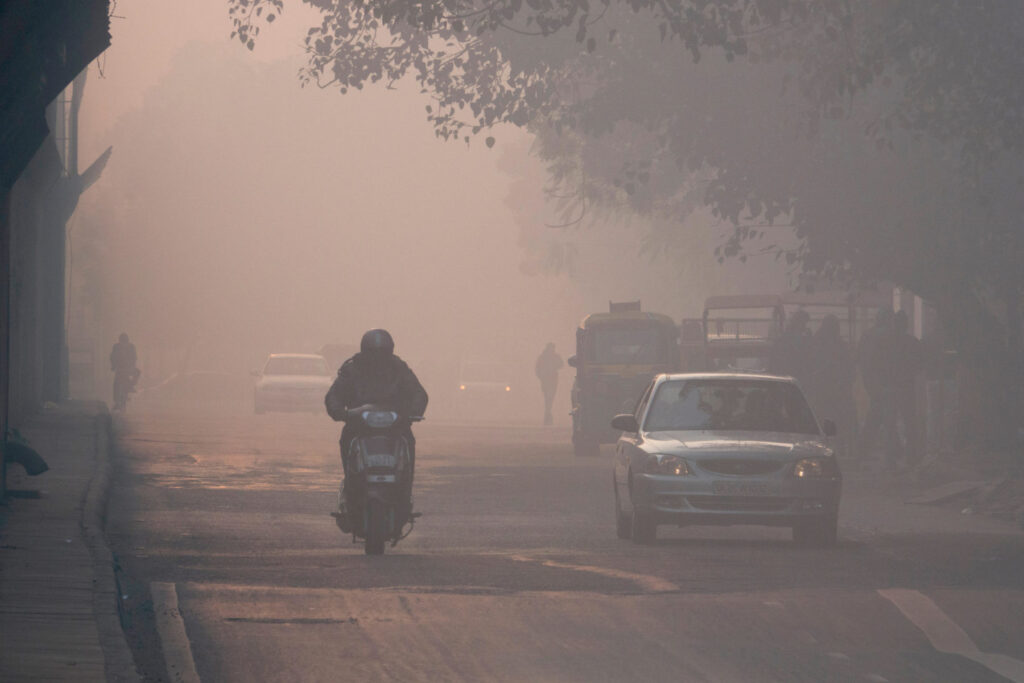Air Pollution: Delhi Gasps For Breath As Haze Persists On 5th Day
Nov 5, 2023 | Pratirodh Bureau
Commuters drive amidst hazardous levels of air pollution in New Delhi
Although the concentration of poisonous PM2.5 was still over 80 times the healthy limit prescribed by the World Health Organisation (WHO), pollution levels in Delhi and its surrounding areas dipped marginally overnight due to a relatively better wind speed.
For the fifth consecutive day, a thick toxic haze lingered over the city, with led doctors to express concerns that air pollution is causing an increase in respiratory and eye problems among children and the elderly.
PM2.5 is fine particulate matter capable of penetrating deep into the respiratory system and triggering health problems. Its concentration exceeded the government-prescribed safe limit of 60 microgrammes per cubic metre by seven to eight times at multiple locations throughout Delhi-NCR. It was between 80 and 100 times the healthy limit of 5 microgrammes per cubic metre set by the WHO.
Over the past week, air quality in Delhi-NCR declined due to a gradual drop in temperature, a surge in post-harvest paddy straw burning across Punjab and Haryana and calm winds that trap pollution.
Central Pollution Control Board data shows that between October 27 and November 3, Delhi’s air quality index increased by over 200 points, culminating in a descent into the “severe plus” category (above 450) on Friday.
Meanwhile, the 24-hour average AQI, which is recorded at 4 pm every day, improved marginally to 415 on Saturday from 468 on Friday. The 24-hour average AQI on Friday was the worst since the previous high of 471, which was recorded on November 12, 2021.
The air quality in neighbouring Gurugram (404), Noida (408), Greater Noida (490), Ghaziabad (394) and Faridabad (438) also reported hazardous air quality.
Delhi’s air quality has the dubious distinction of ranking among the worst int he world’s capital cities. In August, a report by the Energy Policy Institute at the University of Chicago (EPIC) said that air pollution is shortening lives by almost 12 years in Delhi. The hazardous pollution levels have led to many being compelled to forego their morning walks, sports and other outdoor activities.
According to health experts, children breathe faster, thus taking in more pollutants and that has left parents worried.
Combined with emissions from vehicles, paddy straw burning, firecrackers, unfavourable meteorological conditions and other sources of pollution lead to hazardous air quality levels in Delhi-NCR during the winter every year.
An analysis conducted by the Delhi Pollution Control Committee (DPCC) reveals that the capital experiences peak pollution from November 1 to November 15, when the number of incidents of stubble burning increase in Punjab and Haryana.
According to a numerical model-based system developed by the Pune-based Indian Institute of Tropical Meteorology, smoke from stubble burning accounted for 24.5 percent of the PM2.5 pollution in Delhi on Saturday, dropping from 35 percent on Friday.
Starting Thursday, officials at the Commission for Air Quality Management — a central government panel that formulates strategies to combat pollution in Delhi-NCR — expect pollution levels to further decline due to comparatively better meteorological conditions and curbs imposed on certain polluting activities.
The commission, on Friday, deferred the implementation of stricter measures under the Graded Response Action Plan — the name for the air pollution control plan — citing a declining trend in the AQI in the region. Meanwhile, on Thursday, the pollution control body had issued orders to impose a ban on non-essential construction work and certain specific categories of polluting vehicles.
